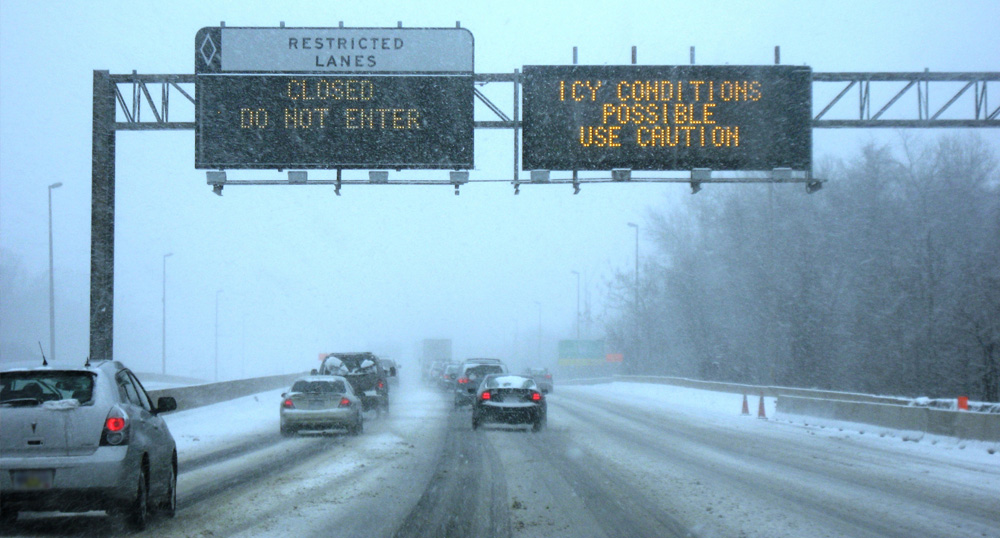When the weather turns frightful, agencies leverage data to support operations and maintenance decisions
As travelers in many States battle winter weather woes, the Every Day Counts round five (EDC-5) initiative on weather-responsive management strategies offers agencies tools to boost the effectiveness of traffic operations and highway maintenance during adverse conditions.
The initiative focuses on using road weather data from mobile and connected vehicle technologies to support proactive traffic and maintenance management strategies. “These strategies improve safety and mobility, reduce the environmental impact of maintenance materials, and decrease operational costs,” said David Johnson, leader of the Federal Highway Administration’s Road Weather and Work Zone Management team.
The strategies apply to more than snowy and icy roadways, Johnson emphasized. “Although winter weather operations are often thought of first, there are many other important applications,” he said, such as flooding events, dust storms, and wildfires.
Working with the EDC-5 team, agencies in 16 States are developing implementation plans and learning more about weather-responsive management strategies. Nine States are demonstrating and assessing approaches to improve traffic operations and highway maintenance. Eleven States have institutionalized weather-responsive management strategies.
To aid deployment, the team created a weather-responsive management strategies toolkit, a one-stop shop for case studies, guidelines, webinars, and reports. This year, in addition to conducting workshops and peer exchanges, the team will continue its bimonthly webinar series. “These events will include early adopters who will provide insight for those looking to enhance their weather-responsive management strategies,” Johnson said.
The Arizona Department of Transportation (ADOT) implemented a dust detection and warning system on a 10-mile stretch of Interstate 10 to quickly tell drivers to reduce speed for safety. The system includes sensors, overhead message boards, variable speed limit signs, and closed-circuit cameras in an area prone to sudden, localized dust storms that diminish visibility.
The system automatically activates variable speed limits when and where needed, lowering speed limits in 10 mile-per-hour increments to as slow as 35 miles per hour. Electronic message boards alert drivers to blowing dust, while ADOT traffic operators use overhead message boards on the way to the dust detection zone to warn drivers of potentially hazardous conditions ahead.
Closed-circuit cameras allow ADOT Traffic Operations Center staff to see real-time conditions on the roadway, while in-pavement sensors report the speed and flow of traffic. The system includes weather radar mounted on a 20-foot tower that can detect storms more than 40 miles away. This radar complements sensors mounted on posts next to the freeway that use light beams to determine the density of dust particles in the air.
In addition to enhancing safety by providing earlier warnings about blowing dust, this innovative system is expected to advance ADOT’s understanding of whether similar technology can be effective in other locations around Arizona.
The Minnesota Department of Transportation (MnDOT) was an early adopter of integrating mobile observation (IMO), which involves instrumenting vehicles with road weather sensors and other automated technologies to acquire data to support decision making. MnDOT plow trucks, supervisor vehicles, and mower tractors collect data such as air and surface temperature, relative humidity, and wiper and brake status. Plow trucks also capture camera images of the road ahead.
 Data from mobile and connected vehicle technologies support traffic management strategies such as posting road condition information during adverse weather.
Data from mobile and connected vehicle technologies support traffic management strategies such as posting road condition information during adverse weather.The agency’s web-based maintenance decision support system uses the IMO data to help maintenance operators and Traffic Management Center staff manage roadways and resources during inclement weather. The system provides road advisories, warnings, and treatment recommendations for road maintenance and serves as a primary resource for forecasting. This robust tool allows MnDOT staff to make more informed decisions for maintenance planning and tactical actions, resulting in improved mobility and safety and more efficient use of materials.
MnDOT leverages its IMO capability to help the public make informed travel decisions. To augment the weather information in its 511 traveler information system, MnDOT’s plow camera web page provides road condition images from active plows. The images are also incorporated into MnDOT’s Condition Acquisition and Reporting System (CARS) website. Staff use CARS and other IMO data to increase situational awareness for posting real-time traveler information on dynamic message signs.
—MORE INFORMATION
Watch an Innovation Spotlight video on how agencies manage traffic operations and highway maintenance during adverse weather conditions.
Visit the EDC events web page to register for webinars on weather-responsive management strategies.
Go to FHWA’s road weather management web page for best practices, publications, and virtual training.
Contact David Johnson of the FHWA Office of Operations for information, technical assistance, and training, including workshops and peer exchanges.
- Cover
- Innovation Synergy: Crowdsourcing Improves Weather Response
- Weather-Responsive Management Strategies
- Filling in Data Gaps With Crowdsourcing
- The Value of Peers
- Using Accelerated Bridge Construction in Seismic Applications
- States Innovate
- Explore Innovation at the Transportation Research Board Meeting
- About Innovator
